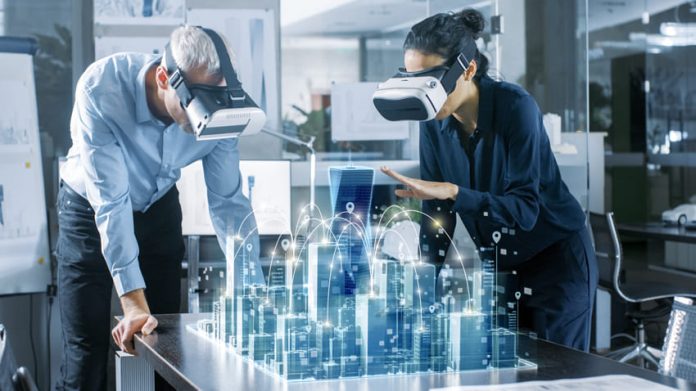Virtual and augmented reality (VR/AR) technologies are rapidly gaining popularity as effective tools for employee training and development. Previously relegated to the realm of science fiction, VR/AR are now commonplace in our daily lives and their value in education is expected to increase significantly in the coming years. By 2023, AR is predicted to reach a value of $5.3 billion, while VR is expected to grow to $640 million.
According to a study conducted by the American Society for Training and Development, companies that invest in training enjoy a 24% higher profit margin. In addition, the study shows that companies that prioritize employee training and development experience a 218% higher income per employee when compared to their counterparts. Despite this, a survey published by Harvard Business Review revealed that companies spend $350 billion annually on employee training, yet the average amount wasted per employee is $13,500 due to ineffective training practices.
This article explores the potential of AR and VR in employee training and development, highlighting the cost-effectiveness and efficiency of these technologies in enhancing learning outcomes and improving overall employee performance.
Benefits of AR/VR for Employee Training and Development
In today’s fast-paced and ever-changing world, businesses need to stay ahead of the game to remain competitive. One of the ways they can achieve this is by investing in the development of their employees. Employee training and development are essential components of building a successful workforce and business analysis strategy. Organizations that provide their employees with adequate training and development opportunities reap numerous benefits, including increased productivity, improved employee retention rates, enhanced job satisfaction, and better customer service. As such, businesses that prioritize employee training and development gain a competitive edge and set themselves up for long-term success.
Enhanced learning experiences
AR/VR technology offers unparalleled opportunities for immersive and personalized learning experiences that are not achievable through traditional offline methods. These tools provide a simulated environment that replicates real-world scenarios, allowing employees to learn and practice new skills in a safe and controlled environment. This allows employees to experiment with different approaches and techniques, making mistakes without fear of real-world consequences. Furthermore, the interactive and dynamic nature of these tools allows for structured and engaging practical activities that enhance knowledge retention and understanding. Employees can learn at their own pace and in their own way, with the flexibility to repeat and revise difficult concepts until they are confident in their abilities. This personalized learning experience helps employees to feel more engaged and motivated, leading to better learning outcomes.
Improved knowledge retention
AR/VR technology provides a more effective and efficient way to acquire new skills and knowledge. With interactive and dynamic visualizations, trainees can gain a deeper understanding of complex concepts, leading to better knowledge retention. In addition, AR/VR tools can simulate scenarios that are difficult to replicate in real life, providing employees with a unique opportunity to experience and learn from them. This is particularly important in industries such as healthcare or aviation, where real-world mistakes can have serious consequences. By providing learners with an opportunity to practice new skills in a simulated environment, AR/VR technology helps them develop and refine their abilities faster and more effectively. This leads to improved performance, increased productivity, and better job satisfaction.
Reduced risk
AR/VR technology offers a safe solution for employees to train for hazardous job situations, minimizing the risk of injury or harm. Investing in AR/VR eliminates the need for expensive physical training equipment and facilities, thereby reducing training costs while ensuring the safety of trainees. For example, an employee in a manufacturing facility can practice operating heavy machinery or working in hazardous conditions without the risk of injury or damage to equipment. This technology also provides a cost-effective alternative to on-the-job training, which can be expensive and risky. AR/VR tools allow employees to practice and refine their skills without disrupting regular work operations. This means that organizations can minimize downtime and reduce the impact of training on productivity.
Cost-Effectiveness of AR/VR for Employee Training and Development
VR headsets are a valuable investment for companies looking to improve their training programs. Although there may be a significant initial cost associated with purchasing VR headsets, they can be reused for various training programs, making them a cost-effective option in the long run when compared to traditional training methods
Cost savings in materials, travel, and equipment
In addition to cost savings, AR and VR technologies also provide significant benefits in terms of training efficiency. By eliminating expenses such as travel and single-use materials, these technologies allow companies to allocate resources towards other important areas of their business.
Increased efficiency in training time
Furthermore, AR and VR provide a highly immersive and personalized learning experience for employees, leading to increased training efficiency. With these technologies, employees can learn at their own pace and receive real-time feedback, resulting in a faster and more effective training experience.
Improved employee engagement and retention
Employee engagement and retention is another area where AR/VR technologies excel. A lack of engagement in training programs can lead to reduced job satisfaction, lower performance levels, and ultimately, termination. However, AR/VR can help address this problem by providing more engaging and interactive learning experience.
Efficiency of AR/VR for Employee Training and Development
Personalized and adaptive training
Personalized and adaptive training is a critical component of XR technologies. By leveraging data analytics and machine learning algorithms, organizations can provide personalized and adaptive training that caters to the individual needs of each learner. This approach leads to better learner engagement, higher knowledge retention, and more efficient training outcomes. Furthermore, the use of adaptive training has been shown to result in improved performance outcomes for employees, increasing the value of the investment made in XR technologies.
Remote training capabilities
In addition to personalized and adaptive training, VR technology has the potential to revolutionize remote training capabilities. With remote training in VR, learners can be fully immersed in simulated real-world scenarios that enable them to practice skills and interact with others in a safe and controlled environment. This immersive experience leads to better knowledge retention, improved communication skills, and ultimately, better performance outcomes for remote learners.
Scalability and ease of implementation
Scalability and ease of implementation are also key benefits of VR training programs. By leveraging the scalability of virtual reality technology, organizations can create immersive training experiences that can be easily adapted to meet the needs of a diverse range of learners. Furthermore, VR training programs have shown to be easy to implement and roll out across various locations, making them a practical and cost-effective solution for organizations looking to enhance their training programs.
Case Studies on AR/VR for Employee Training and Development
Businesses across the globe are recognizing the value of adopting cutting-edge technology to enhance the effectiveness of their employee training programs. One notable example of this trend is Verizon, a telecommunications giant in the United States.
Verizon has implemented VR training to prepare their call-center employees for the challenges they may face while handling difficult customers, which happens in their day-to-day work. After practicing three times in VR, Verizon employees had notably improved their levels of calmness, verbal fluency, confidence, and relaxation, which are all essential components for successful customer satisfaction and de-escalation of difficult conversations.
Another compelling example of the benefits of VR training is showcased by Johnson & Johnson, a multinational healthcare corporation. In 2017, it implemented VR simulations to train surgeons on orthopedic device implantation. This innovative approach to surgical training was later refined and expanded by Osso VR, which has demonstrated significant improvements in student performance and engagement. Students trained with Osso VR showed a 233% greater score and completed 252% more steps compared to those using passive learning tools.
Nestlé‘s VR training program is a standout example of how scalable and adaptable VR training can improve employee safety and performance outcomes while reducing risks in the workplace. It provides an immersive and interactive experience that allows employees to practice safety protocols in a controlled environment. The program is easily implemented and can be adapted to local conditions, making it a practical and cost-effective solution for organizations.
Thus, the implementation of VR technology has demonstrated its game-changing potential, reinforcing the advantages of VR across various industries and the value of investing in innovative training methods.
Potential Challenges of AR/VR for Employee Training and Development
Technological limitations and costs
Although AR/VR training offers numerous advantages, it also presents potential challenges. One of these challenges is the need for regular hardware, software, and accessory updates, which can be costly. Moreover, VR training solutions can be more expensive than other training methods, making scalability an issue. Implementation costs can range from $20,000 to $150,000 or more due to the necessary hardware and software. However, with the rising popularity of VR training, development costs and headset prices are expected to decrease significantly, making it a more cost-effective option in the future.
Employee adoption and accessibility
The implementation of immersive technologies for employee training can pose challenges in terms of employee adoption and accessibility. Adequate training and support are necessary to ensure widespread adoption. Furthermore, employees with physical disabilities or visual impairments may not be able to use VR devices due to accessibility restrictions. To ensure that all employees have equal access to learning opportunities, alternative training methods should be available.
Ethical considerations
Another potential challenge is related to ethical considerations. Immersive technologies can create highly realistic simulations that may expose employees to uncomfortable or even traumatic situations. Additionally, it is essential to ensure that the training follows clear policies and guidelines to protect the privacy and security of all employees involved.
Conclusion
Investing in AR/VR training is a smart move for businesses looking to stay competitive and meet the evolving needs of their workforce. VR training assist in the creation of a wide range of scenarios that may be challenging or expensive to replicate in real life. For example, medical professionals can practice complex surgical procedures, firefighters can simulate various emergency situations, and astronauts can train for space missions, all within a virtual environment. These technologies not only improve retention rates and reduce costs and risks, but they also enhance overall effectiveness. As more and more organizations adopt AR/VR training, it will become an increasingly integral part of the eLearning solutions landscape. By embracing innovative training methods and keeping up with these trends, businesses can ensure their employees have access to the most effective and engaging learning experiences. Incorporating AR/VR technology into your eLearning strategy can provide numerous benefits for both employees and organizations, making it an investment that is well worth considering for improved employee performance and organizational success.



































